Ultras are just eating and drinking contests, with a little exercise and scenery thrown in.
– Sunny Blende, M.S., Sports Nutritionist

Let’s call this one Giddy Anticipation
The final a cappella tones of the National Anthem drifted away on the chill morning breeze, and like that we were fully exposed. Not just to the frigid temperatures, but to the epic challenge ahead of us. Dan and Otter’s pent-up energy crackled on either side of me, my lowfat frame shivering between them in its bid to stay warm. Curiously my full-body shiver response was most vigorous in my posterior, as though the spirit of Beyoncé had suddenly occupied Château Caucasia.
I tried to savor the moment, focusing on the fact this would be far more than a novel challenge at a longer distance. Over the next 12 hours I’d be attempting to run 50 miles—19 more than I’d ever run in one day, and roughly the same mileage I’d been totaling on a weekly basis for the past several months. And yet I felt an extraordinary and almost unsettling sense of calm—was mine the blissful ignorance of a turkey accepting an invitation to Thanksgiving dinner?
Shivering backside notwithstanding, the weather in Kettle Moraine State Forest would be perfect for the task at hand: cloudy skies to minimize the sun’s influence; cooler temps to prevent overheating, not to mention deter bugs (including ticks!) & allergens; and light intermittent rains in the days leading up to the race, which ensured we’d be running on cushiony trails free of dust. If the weather gods had instructed me to “Take as much time as you need,” I couldn’t have designed more ideal conditions.
All that said, my brain kept circling back to the same question: Was I ready to run 50 miles? The answer was as clear as the patchy mud all around us:
I have no idea.
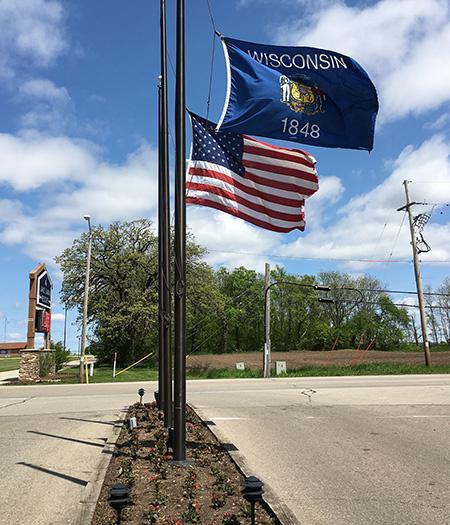
Dan & Otter had arrived in Kettle Moraine—Dan with his father-in-law Steve, Otter with his girlfriend Lisa—in search of redemption. Dan had dropped at mile 39.3 of the North Country 50-Mile Run three years earlier, the victim of ill-timed patellofemoral pain syndrome (runner’s knee), while Otter had dropped at mile 43.3 of last year’s Ice Age 50 due to time-limit concerns. For each of them, revenge would be a dish best served cold—and cloudy, and windy. So we all had something to prove.
Before we’d even crossed the Wisconsin border, our best-laid plans had nearly gone astray. In a classic case of not AGAIN, Dan had experienced a flareup in his left knee ahead of last month’s Silurian Springs 25K, dropping from the 50K to the 25K as a result. He’d finished the 25K strong, but had since been babying the knee in preparation for Ice Age—meaning his training regimen over the past month had been limited. For his part, Otter was recovering from a nasty cold that still sent him into the occasional coughing fit. Of all the recreational options you might choose on a weakened immune system, an ultramarathon wouldn’t be high on that list.
Me, I’d be the healthiest among us, coming off back-to-back marathons six days apart in Boston & Big Sur. If anything, my concern was OVERtraining, and a resulting lack of energy similar to what had flummoxed in Boston. But having curtailed my training significantly in the three weeks since Big Sur, I was eager to find out how well my body had recovered from two beatings on concrete in close succession. Unfortunately, with all my training focused on road marathons in Boston and Big Sur, my trail time in recent months had been minimal. And in fact, by crossing the finish line at Ice Age I would have tripled the mileage on my trail shoes. So this would definitely be a trial (or trail) by fire.
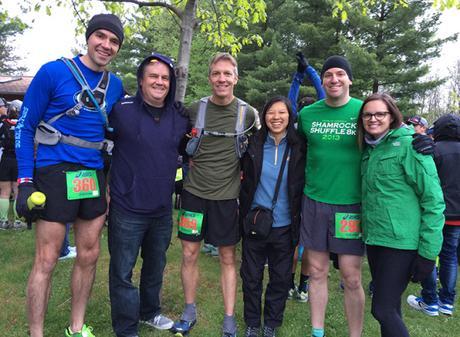
All for one, and one for all! (L-R: Dan, Steve, me, Katie, Otter, Lisa) (photo: Dan Solera)
During our group carbo-loading session the night before, Dan and I had admitted to the same ambitious goal. Whereas “Just finish (in under 12 hours)” was our overall goal for the day, we’d set our best-case scenario at under 10 hours. Because if you’re going to run the race, you may as well aim high. At an average pace of 12:00/mile I knew we could do it—if everything went smoothly and according to plan {cue mad scientist laugh}.
By definition it would be a long day of running and—based on every first-timer story I’d ever read or heard—an inevitable sufferfest. Anticipating that, I’d divided the race mentally into a series of five 10-milers. Here’s how I expected the day to unfold:
Miles 1-10: Start strong, feel great to be running through the forest with friends
Miles 11-20: Settle in, maintain a comfortable pace, ensure all systems are go
Miles 21-30: The struggle officially begins as I pass the marathon mark and approach my longest-ever distance (50K)
Miles 31-40: Fatigue sets in, legs tighten and focus dwindles; if my nutrition isn’t dialed in, the wheels could come off in a hurry
Miles 41-50: Hang on for dear life, channel my inner Dean Karnazes (“Run when you can, walk if you have to, crawl if you must; just never give up”), do whatever it takes to reach the finish line in under 12 hours.
As it turns out, truth really is stranger than fiction.

The plan was to sleep like a baby before the race & eat like one during it
Miles 1–10 (Green means GO)
As the National Anthem faded, race director Jeff Mallach wasted no time sending us on our way with a flurry of cheers from both runners & spectators. The three of us immediately set about debating whether, with a 6:04am start time, the cutoff would be 12 hours later or 6:00pm sharp. The unspoken hope was that none of us would need to care.
I’d agreed with Dan & Otter’s plan to stay together for the first 9-mile loop, to ensure we kept each other in check while maintaining a smart & steady pace. The wide & welcoming Nordic Trail was trail running at its finest, with rain-softened dirt and grasses cushioning every step amid radiant surroundings, as though the entire forest had recently been treated to a fresh coat of green paint. I could see how, in late autumn before the first snowfall, our route might resemble a scene from “The Blair Witch Project,” with skeletal trees and naked dirt casting a dull, uniform brown over the entire scene. Now though, with the flush of spring fresh on its cheeks, coupled with the recent rains, Kettle Moraine could easily have passed for the Pacific Northwest.
Cruising though the conifers we conversed easily, sharing stories and enjoying this day we’d planned for a year, seemingly oblivious to the 40+ more miles we still had to run. This steady stream of conversation also ensured we were never working hard enough to get out of breath. We took turns running in pairs on the wide doubletrack, occasionally emerging from the forest into a wind-exposed meadow before being swallowed again by the soaring canopy of towering evergreens and more modest hardwoods.
At one point, curious about the plant life lining the trail I pointed down and asked “Any idea what this is?”—to which I got simultaneous reponses of “grass” (from Otter) and “dirt” (from Dan). Ask a silly question…
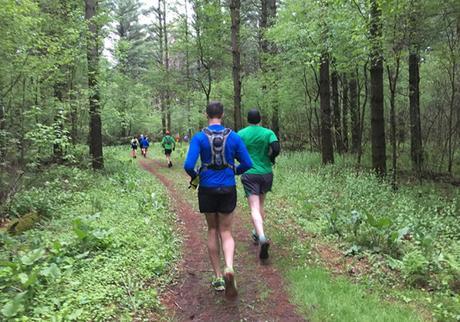
Dan & Otter set the pace on the Nordic Trail
On every incline, even those of moderate ascent, we’d slow to a hike to stay within our aerobic (fat-burning) zone. And here I was lucky to be running with two ultra vets, since this strategy flew in the face of my training & programming. I’ve always conditioned myself to run uphill until either I’m out of breath or I can’t lift my quads—basically run ‘til I can’t run, then hike ‘til I can run again. This was another reason Otter had smartly recommended we run together—he knew the temptation to attack those early hills would be strong. And he knew energy saved now would prevent an ugly bonk later.
Before I knew it we’d come full circle and reached the start line aid station (mile 9), where Katie, Lisa & Steve—on this day the Most Valuable Crew—waited. Glancing over my dining options, I grabbed one quarter of a PB&J and a cup of the original sports drink, Mountain Dew. It had been years—check that, decades—since I’d tasted Mountain Dew, and on this day we’d be reunited like old friends.
Given we were running ~10 minutes ahead of Otter’s projected time, Steve looked at me with clear trepidation in his eyes and made a gentle “take it easy” gesture with his hands. “You guys are pacing this really well” he said diplomatically, which I understood to mean “I know you feel great now, but you have a long way to go—don’t do anything stupid and flame out early.” Feeling a swell of appreciation, I assured him we’d been running comfortably and hiking the uphills. And I knew Dan would be in very capable hands for the next 41 miles.
Not wanting to waste time at this first stop, I exchanged “See you soon”s with Katie and pushed on ahead of Dan & Otter, our tacit agreement being that after the first 9 miles we’d run at our own pace.
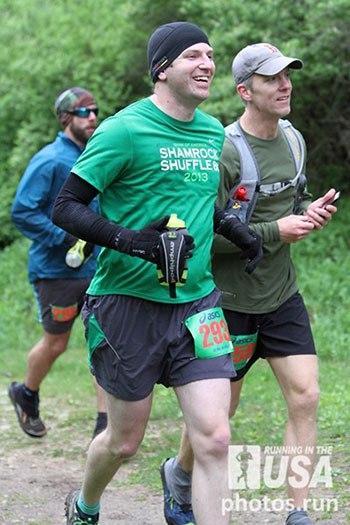
(photo: Bill Flaws, Running in the USA)
I seldom use aid stations for anything more than the occasional cup of water, since I don’t sweat much and prefer to carry (and trust) my own nutrition. But knowing I’d need them early & often at Ice Age, I’d resolved to get in & out of each one as fast as possible. Otter had made another valid point here: assuming 15 aid station stops at 4 minutes per (not a long time when you’re hungry, stiff & tired), you’ve already sacrificed an entire hour of your race to the aid station gods. So get in, get what you need and get out.
To keep my hands free (in case of a fall) I’d ruled against carrying a bottle in favor of my hydration pack, which I filled with a liter of Skratch Labs drink mix (water + electrolytes) along with pouches of puréed (i.e. baby) food and packets of GU. I wanted my go-to nutrition to be as easily digestible and stomach-friendly as possible, supplemented by aid station bananas and PB&J. Nom nom.
I’m not the superstitious sort, but I do subscribe to the theory that the more you pack, the less you’ll need. For that reason I’d packed enough wardrobe options to make Katy Perry jealous. Katie had several potential changes of clothes & shoes ready to go, in case anything rubbed, chafed, or blistered. And I’d brought hiking poles in the event any of us needed extra support late in the race. I also carried bandaids, baby wipes for ‘tween-aid-station emergencies and a 5-Hour Energy for a shot of caffeine late in the race. Plus, I’d be carrying my iPhone in my Spibelt for picture-taking purposes. Boy Scouts ain’t got nothin’ on me!
One ten-mile race down, four to go.
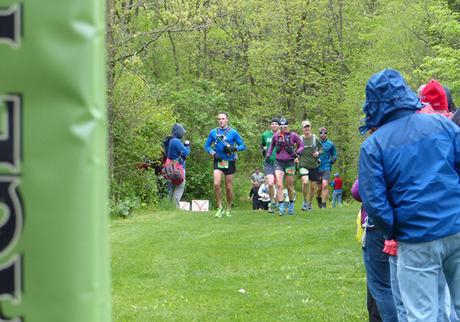
Full circle: Dan leads the way back through the start line at mile 9
Miles 11–20 (Settling in on the singletrack)
Quickly I reached Confusion Corner at mile 11, which on this day was most notable for its lack of confusion. There, a helpful volunteer directed everyone onto the Ice Age Trail for the out-and-back to Rice Lake. In fact, the entire course was free of confusion and impeccably marked, with yellow flags denoting the 50-mile route and orange flags the 50K. Even with my notoriously faulty sense of direction, I was never in danger of taking a wrong turn.
Here on the beautifully groomed singletrack of the Ice Age Trail, a game of leapfrog developed which would hold for the next 20 miles. At each aid station I’d fuel up quickly and leave ahead of Dan, who would soon overtake & pass me with a whoop of warning or—in one case—the theme from “Jaws”. He’d dance by and gradually extend his lead with long fluid strides… then we’d hit a descent and he’d gracefully airwalk downhill as if it were a treadmill, while I tediously picked my way over rocks & roots or down wooden-framed steps, careful not to treat those around me to my first face-plant of the day.
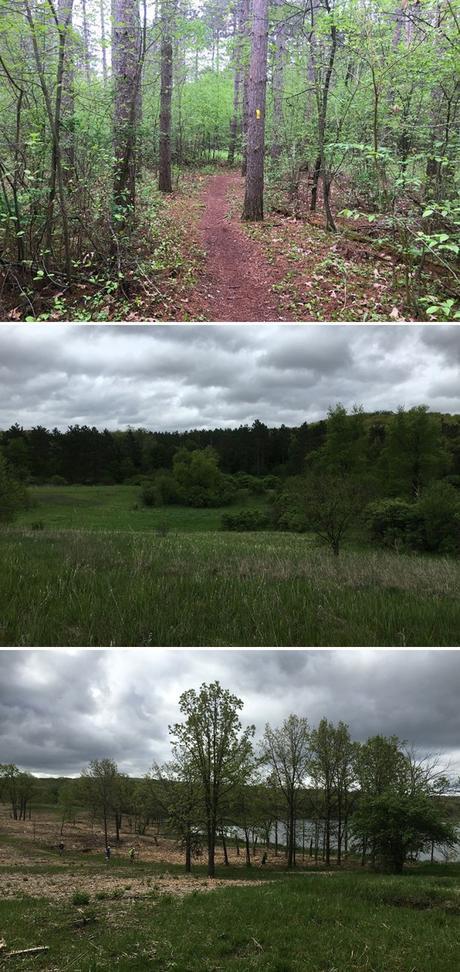
Scenes from the Ice Age Trail, Section 2 (miles 11-32)
At one point Dan turned a corner 30 feet ahead of me, and by the time I reached the same spot he was already down a hill and out of sight around the next bend, like a will-o’-the-wisp in running shoes. As much as I wanted to chase him down, though, I focused instead on maintaining a steady, comfortable pace, reminding myself to keep my eyes on the prize—the finish line was still a long way off.
Besides, Dan & Otter had a bit of a home-field advantage here, having made the two-hour drive from their hometown Chicago several times in recent months to train on these trails. So far though, I had to admit—I was thoroughly enjoying my own personal introduction to Kettle Moraine.
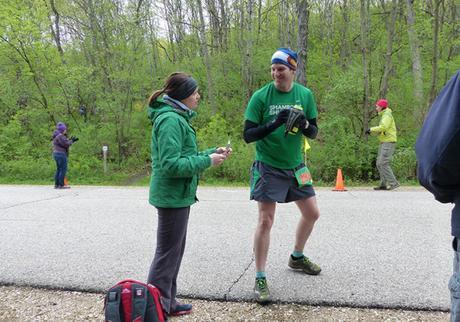
Lisa & Otter review their strategery, mile 13.1
Aid station stops became models of efficiency. Katie and Lisa would cheer us in as we approached, Lisa bundled in a hooded green winter jacket that had scantily clad runners telling her she looked cold. Katie, nestled deep within her own poofy jacket, would greet me each time with the agreed-upon “What do you need?” She’d hand me a pouch of puréed food, which I’d down along with ¼ PB&J, two bites of banana, a cup of Mountain Dew and a few sips of water before heading out again. Easy peasy, baby food squeezy.
Both the men’s and women’s leaders flew by us along this stretch, headed back toward Confusion Corner well ahead of their pursuers. Lead woman Larisa Dannis (7:05:56) glided past us, moving purposefully and looking sharp in her INKnBURN gear. I too had donned INKnBURN shorts for the race, mainly for practical reasons since they’re the most comfortable running shorts I own. Unfortunately, any similarity between our running styles ended there.
Two ten-mile races down, three to go.
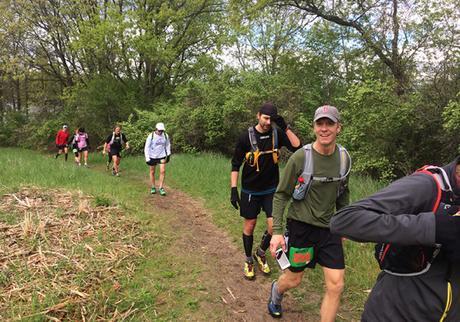
Uphill caravan, mile 15 (photo: Dan Solera)
Miles 21–30 (Waiting for The Wall)
I rolled into the turnaround at Rice Lake (mile 21.7) feeling strong and silently lauding the cool weather—on a warmer day, this course could have been much less hospitable, with the reeds around Rice Lake providing a haven for swarming gnats and hungry no-see-ums. Again I hastened through my aid station routine, doing a few leg lifts this time to keep my hip flexors loose. Dan had a similar idea, holding Steve’s hands as he leaned back in an upright sitting position to stretch both quads & hamstrings. I fueled up, gulped down my obligatory shot of Mountain Dew and continued back the way I’d come.

Rice Lake, mile 22
At each aid station I marveled at the selflessness of the volunteers, incredible people who were donating pretty much an entire day of their lives to stand out in the cold for us, to restock food for us, to pour drinks for us, and to ensure that each & every runner who passed through their aid station had exactly what they needed. “You’re doing all the hard work!” they’d respond modestly when I thanked them. I wish I’d had the time & wits to stop and chat with every volunteer, since some have been doing this for over 20 years. I say it in pretty much every race recap, and it rang especially true at Ice Age—volunteers they make the running world go ‘round.
At every mile I mutely celebrated the satisfying beep of my Garmin and immediately looked forward to the next, appreciating life as an endorphin junkie. Dan and I were now running alone in the damp woods, trading the occasional snippet of conversation but otherwise focused on the task at hand. These moments of easy comradery were among the highlights of the day, and I wouldn’t have traded them for a course record.
As we passed the 25-mile mark, I pointed out optimistically that we’d now be counting down mileage to the finish. And I understood Dan’s reluctance to count unhatched chickens—while mile 25 may be the physical midway point of the course, we both knew the next 25 miles would feel much longer than the first 25. Nonetheless the thought of counting down miles with less than a marathon to go provided a nice psychological pick-me-up. And I was quick to seize on any available edge, real or perceived.
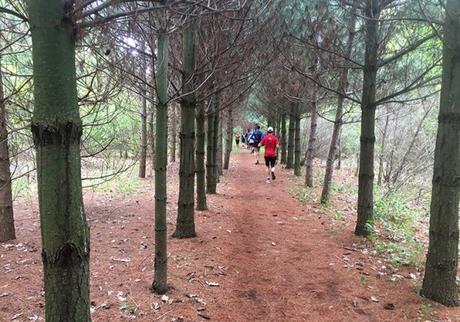
Rain—no wait, are those sleet pellets?—began to fall lightly at the marathon (mile 26.2) mark, so gentle and transient as to be nothing more than an amusing distraction. A brisk, chilling breeze periodically flexed its muscles as we traversed open meadows or paused at exposed aid stations, but at no time did I ever feel too warm or too cold. All day long I was the Goldilocks of ultramarathoners, my body temperature juuuuust right.
As I neared the aid station at mile 30.2, I felt my core and upper quads starting to tighten noticeably and thought Uh oh, here we go. In response, I added leg lifts & leg swings to my aid station routine, setting Katie’s expectations that it would take me longer to cover miles 30–40 (to reach our next rendezvous point at mile 40.2) than it had the previous 10 miles. Her expression never deviated from calm and reassuring, confirming I still looked as good as I felt. So much so that I decided not to grab my headphones, since the idea of distracting from the awesomeness around me with a playlist or podcast felt counterproductive. If anything I wanted to be more in tune with my body and my surroundings, not less. So far, so good.
Three ten-mile races down, two to go.
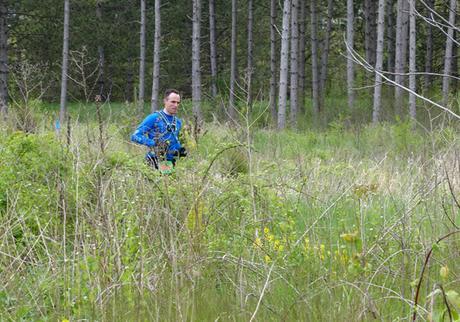
“I know I left those legs around here somewhere.”
Miles 31–40 (Where no Mike has gone before)
Again I left the aid station ahead of Dan, who was likewise looking strong & poised for the final 20 miles. Given that crew members would be unable to access aid stations for the next 10 miles, this stretch promised to feel like the longest yet.
Reaching the 50K (mile 31.1) mark, I recognized the occasion by pausing for a “longest run ever” selfie. Also along this stretch I paused for the first and only time to relieve myself. Unfortunately, despite the 56,000 acres of dirt-, grass- and pine needle-carpeted forest surrounding me on all sides, in my preoccupation to shield myself from oncoming runners I somehow managed to empty my bladder directly on my shoetop. And all I could do was laugh at my own sad ineptitude. Watch that sock get wet now & cause blisters, I thought, wiggling my toes and shaking my foot like a wet dog before forging ahead.
If I were to voice one—complaint is too strong a word—reservation about Ice Age, it would be the two-way traffic on the out-and-backs, particularly when the leaders would fly by like methed-up gazelles. Two-way traffic is admittedly unavoidable, and the vast majority of runners handled it with grace and aplomb, recognizing for example that downhill runners have the right-of-way. That said, the occasional miscreant would come barreling down the middle of the singletrack trail with their head down like a charging rhino, forcing anyone in their path to hop off the trail or distort their tired body to avoid a nasty head-on collision. Trail runners are typically easy-going folks and these instances were rare, but even once was too much at a race like Ice Age, where sharing the trail is the only way everyone can achieve the same ambitious goal.
Despite the two-way traffic, throughout the day I enjoyed several miles of what I love most about trails—no traffic, no red lights, no dogs barking from behind chain-link fences, just running alone in a quiet, beautiful place. Ever the voice of experience, Otter had recommended we each adopt a mantra for when the going got tough. I’d jokingly channeled my inner gladiator and suggested “ARE YOU NOT ENTERTAINED?” But at the moment it fit perfectly… because I really was.
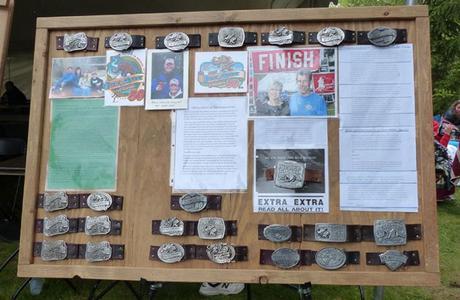
24 years of Ice Age glory on display
At some point light snowflakes fluttered around me, dissipating as quickly as the sleet. Then the sun broke through the clouds, providing a brief respite of warmth before again retreating, this time for good. It was as though the god of weather had entrusted the day to his young and inexperienced protégé.
But where was Dan? Here the aid stations were spaced 3 and 4 miles apart, and each one I departed without seeing him enter. He hadn’t been far behind me at mile 30.2, and I felt a twinge of concern that his knee might be acting up. Vanquishing it immediately, I assured myself he was fine and probably just battling the same heavy-leggedness I’d felt at mile 30 (which, amazingly, had dissipated as quickly as the sleet and snow). And I was confident Otter would be having an excellent adventure of his own.
As I reached the Horserider’s aid station at mile 37, my Garmin chirped a warning and displayed a “LOW BATTERY” message. Shite. Quickly I flipped the display from my real-time stats to time-of-day only, hoping to conserve as much battery life as possible. I hadn’t glanced at my wrist all day, appreciating my Garmin only for its regular mile updates. Sure I’d assumed my battery wouldn’t survive the entire 12 hours, but this was even earlier than anticipated.
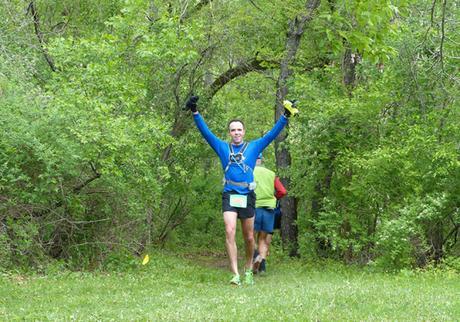
Sometimes you see the camera before it sees you (Rice Lake, mile 21.7)
The hills kept coming. Otter had warned us that this third section of the course, the 18-mile out-and-back to the Emma Carlin aid station, would be “objectively the hilliest… both in terms of the number of hills, as well as the overall elevation gain”. This included one of the toughest climbs of the course in Bald Bluff at mile 35. And yet the hills never felt interminable, nor were any as severe as the ones I frequent in California. My memory may be deceiving me here, but each hill seemed to be followed by a stretch of highly runnable terrain.
I continued to stay within my aerobic zone, power-hiking the steeper hills—always with hands on quads, for better stability and more power—while running the gentler ones. The frequency of my uphill running increased with each passing mile. And in fact I felt more comfortable running the uphills, since the most challenging part of these later miles was restarting from a standstill each time I crested a hill or left an aid station. Once I’d get the legs cranking again, though, it was all good.
During an ultra, “It’s not so much if you’re going to have stomach problems, it’s when you’re going to have stomach problems, and what you’re going to do about it,” says sports nutritionist and ultramarathoner Sunny Blende. That said, my stomach defied convention all day long by behaving like a baby asleep in the back seat of a car. Sure, by mile 37 the PB&J sandwiches were getting a bit stale and increasingly difficult to swallow. But my stomach never faltered, a fact I attribute to 1) the weather, 2) Otter’s advice to eat early & often, and 3) my reliance on real food, puréed and otherwise, rather than lab-synthesized maltodextrin and Soylent Green.
Baby food, PB&J, Mountain Dew, banana, water… baby food, PB&J, Mountain Dew, banana, water… Welcome to the machine, I thought wryly.
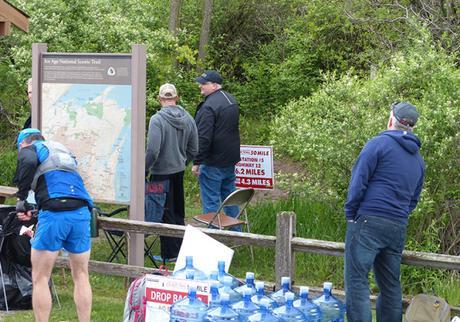
Steve plays sentry at mile 17.3
Several times I lost focus and scuffed my toe on a rogue rock or root, lurching forward but regaining my balance in time to prevent a fall. Until finally it happened — just before the mile 40 turnaround, I lifted my right foot one inch to clear a two-inch high rock and tumbled forward in a flying somersault tuck with a half-twist, landing softly in the green foliage beside the trail. Alone and unfazed, I hopped up and continued on my way, relieved that I’d finally put that inevitable episode behind me. I’m used to face-planting on dusty rocky SoCal trails, so falling in Kettle Moraine was like landing on unicorn feathers.
I saw Katie, Lisa & Steve for the ninth and final time at the Emma Carlin aid station (mile 40.2). His brow furrowed, Steve signaled at me to ask whether I’d seen Dan. I gestured back that I hadn’t. Approaching the food table I admitted to the volunteers, “I thought Emma Carlin was the stuff of legend, I can’t believe I’m actually here”. They assured me they were real and that I was still standing. They also informed me the bar was open, and I glanced back to see a table stocked with Samuel Adams and sporting a “Flatlander Ultrarunners” sign. Who in their right mind, at mile 40 of an ultramarathon…? I thought. Clearly I wasn’t thinking straight or I would’ve known the answer…
I knew better than to sit down, not that I felt like it. Aid station fatigue was setting in, but as tired as I was of eating PB&J and drinking Mountain Dew, 10 more miles felt like nothing, and I almost felt like I could reach out and touch the finish line. My nutrition was dialed in and my body felt good—time to buckle down (pun intended) and get this done. I gave Katie a peck on the forehead and told her I’d see her at the finish.
Four ten-mile races down, one to go.
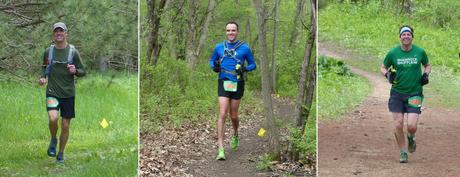
It was a #RunHappy kind of day in Kettle Moraine
Miles 41–50 (DNF = Do Nothing Fatal)
The main benefit of the out-and-back course layout was that roughly five minutes after leaving Emma Carlin, I passed Dan coming the other way. I felt a shot of adrenaline on seeing him, as he looked to be in high spirits and trained his camera on me as I approached. And that was the definitive moment I realized Damn, we are all going to finish this thing.
Fifteen minutes later I passed Otter, pulsing with characteristic energy and a manic look in his eyes. I blurted out encouragement in passing, his response reaching my ears Doppler-style as he never broke stride: “YOU BETTER GET GOING, ‘CUZ I’M GOING TO CATCH YOU!” Absurd as his words sounded, his voice was so strong and so full of conviction that for one brief moment it crossed my mind, He may actually mean it.
What happened next was nothing short of amazing—and I missed it. Otter rolled into Emma Carlin and took the Flatlanders up on their offer to do a beer bong. At mile 40 of a 50-miler. In his defense, he did choose a light beer—and I can’t help but think this was a symbolic middle finger to his 2015 Ice Age effort, which ended prematurely at mile 43.3.
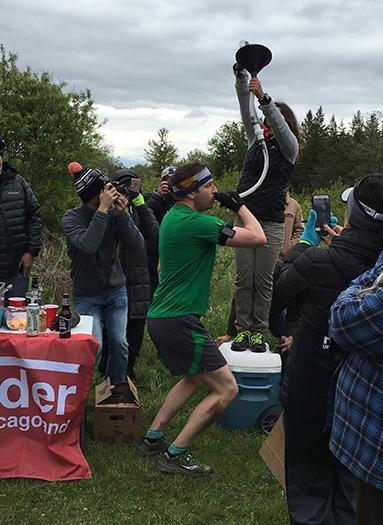
Otter demonstrates proper mile 40 beer bong technique as the paparazzi look on in awe
When I heard about Otter’s Emma Carlin moment I felt amused sympathy for Lisa, who as his crew had gamely shouldered the responsibility for ensuring he had everything he needed when he needed it—food, water, ibuprofen, salt tablets, etc. So I could only imagine how she must have felt on seeing him sidle up to the Flatlanders’ dehydration station. On the most pleasant day, hers (and Katie’s and Steve’s) could easily be construed as a thankless job. On this day, though, with temperatures peaking in the 40s and aid stations exposed to a bone-chilling wind, the job of crew member verged on cruel & unusual. Luckily Lisa’s Michigan constitution and sense of humor shined through when she needed them most.
With one final chirp of surrender, my Garmin bid the day farewell just short of mile 41. For the final 9 miles I’d be on my own, without the addictive beep of each mile marker to count on.
For most runners, the scarlet letters “DNF” mean “Did Not Finish”, but ultrarunners like to joke that they stand for “Did Nothing Fatal”. And that was my goal over those final 10 miles. I’d come too far to lose focus now—one errant step or ill-timed face-plant could negate the past 8+ hours of effort, particularly on the downhills where my stiffening legs had lost much of their earlier flexibility.
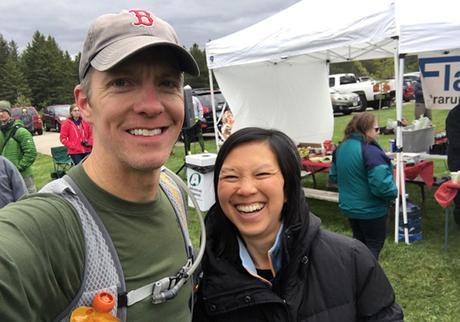
Nothin’ but happy at mile 40.2
Steve had witnessed just such a game-changer firsthand at mile 30. He’d helped a fellow who’d fallen on the trail and sustained a nasty cut beside his left eye, a cut requiring medical attention that ended his own race not with a bang but a whimper.
Under the verdant canopy my eyes remained glued to the damp ground, dancing over rocks and roots, triangulating my next step before darting ahead to map out my next three. I took what the trail gave, never forcing the issue—each step as long or as short, as lithe or as deliberate as the capricious terrain dictated.
And I pondered the question: How was this happening? Other than predictable fatigue my feet, legs and body felt strong. Where were the cramps? Where were the heaves? Not even a blister to provide some discomfort drama over these last few miles. With my past 1½ years of training being dominated by Boston, I’d forgotten just how much I missed trail running.
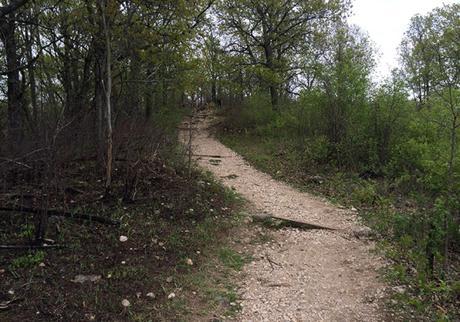
One section of Bald Bluff, the toughest climb on the course (photo: Dan Solera)
With a dead Garmin and a refusal to glance at my iPhone, I had no idea how much time had elapsed or what my pace was. Was a 10-hour finish still reasonable? I told myself Dan would be charging up from behind at any second, dancing by me and disappearing down the next hill out of sight. So I needed to bear down and maintain my pace—now was not the time to give in to fatigue. Run those flats! Hike those hills! Don’t let off the throttle!
The gentle crunch of my footfalls, the measured timbre of my breathing and the hypnotic swish of liquid in my hydration pack were the only sounds audible in the dormant forest.
At the mile 43.3 aid station, I deviated from my routine ever so slightly for an experiment, popping a salt tablet in my mouth before heading out again. I wasn’t sweating heavily and I didn’t feel low on salt; nonetheless I figured I’d give it a shot to see if it made a difference. As my tongue recoiled from the pungent grains I realized NOPE, salt wasn’t what I needed, and spat the capsule into the bushes. Lesson learned.
Approaching the penultimate aid station at mile 47.6, it struck me that I’d effectively whittled the challenge of the day down to the Ice Age 5K. Someone had posted a handwritten sign that read “IF YOU START TO FEEL GOOD DURING AN ULTRA, DON’T WORRY, YOU WILL GET OVER IT”—and I marveled again that so much conventional ultrarunning wisdom had gone out the window here in Kettle Moraine. I gulped down one last cup of Mountain Dew and pushed ahead, blowing past the final aid station 0.9 miles later with a nod of appreciation. “1½ miles to go!” the volunteer confirmed as I passed.
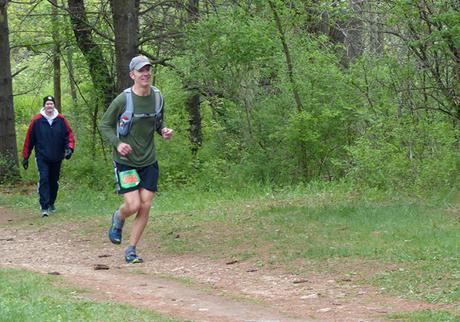
Still looking Instagram-purty after 50 miles
Like an audio tour of the course, Otter’s voice in my head shepherded me toward the finish. “Remember this hill,” he’d said as we’d tackled our first descent on fresh legs. “On your way back this will be your last uphill before the finish.” Then that hill was behind me, and I wanted to hug the bundled-up couple who informed me I had a quarter mile to go. Oh, what a feeling.
A wave of awestruck pride washed over me on spying the lime green FINISH banner directly ahead. I high-fived Steve, then Katie, and then I spotted it—the official timer clock perched next to the finish line, dispassionately reducing the blood, sweat & tears of each finisher to six unique digits. Mine were 09:54:30.
I’d broken 10 hours.
Holy SHIT.
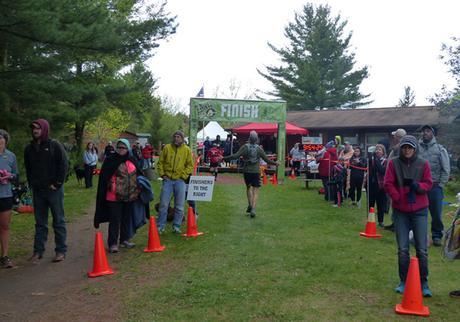
A mammoth accomplishment
Gratefully I accepted my first-ever finisher buckle—embossed with woolly mammoth mascot—then wrapped a beaming Katie in a huge embrace that was 50 miles & 10 hours in the making. Quickly I changed into warm dry clothes before staking out a spot at the finish to wait for Dan. He emerged from the woods a short time later, arms raised triumphantly in understated celebration. An animated Otter followed 50 minutes later, spiking his water bottle just short of the finish line before flying across, wings up. As he rode his adrenaline high into the finish area where Lisa awaited, I heard someone nearby tell their friends, “That was the fellow who did the beer bong.” And with that, Otter forever became a cult hero among the Ice Age faithful.
Runners & crew reunited in the finish area, where we piled our plates high with food and giddily relived the past 11+ hours. Only after wrapping myself in two blankets (kindly provided by Lisa) did I stop shivering, an unfortunate side effect of having run for 10 hours in cold weather with very little body fat. As the official clock neared the 12-hour time limit, we creakily stood to cheer the final few finishers across the line, one of whom generated some last-minute drama by face-planting less than 100 feet from the finish.
Whereas in Boston I wished I could bottle the experience, at Ice Age I wished I could bottle both the experience and my performance. I’m not sure I could run a more steady race than this one. It was as though I’d come to Kettle Moraine expecting to have to solve a Rubik’s Cube blindfolded, only to find on race day that all six sides were the same color.
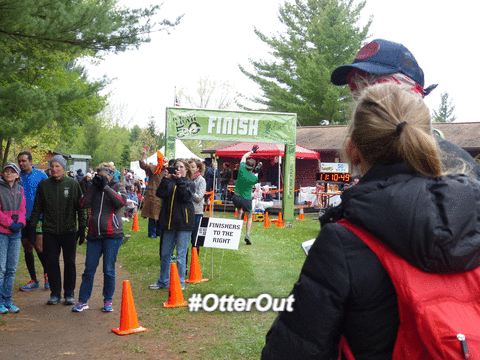
Otter channels his inner Rob Gronkowski
I want to say I endured tremendous suffering, and experienced epiphanic moments of clarity that come with taxing the human body to its limits. But I didn’t. I want to say this was my toughest running challenge yet. But it wasn’t—that title still goes to the 2012 Mount Diablo Trails Challenge 50K, where a freak heat wave taught me the true definition of endurance. And I want to say I left it all out on the lush trails of Kettle Moraine, emptying the tank and giving all I had to give. But I can’t—and in fact, less than 48 hours after Ice Age my legs felt as though I’d actually taken the weekend off. Empirically speaking, 10 slower hours on soft dirt is much more forgiving than 3½ faster hours on concrete.
Ice Age was a confluence of many factors that added up to an awesome race— among them an inspiring course, perfect weather and (maybe more anything) unmatched comradery. It certainly helped that one of those comrades was an eager fount of ultrawisdom, since Otter’s pre-race advice & enthusiasm—beginning months in advance—played a key role in my arriving at the Nordic Trailhead feeling relaxed and ready. As Peyton Manning once said, “Pressure is something you feel when you don’t know what the hell you’re doing.” On Saturday, the three of us knew what the hell we were doing.
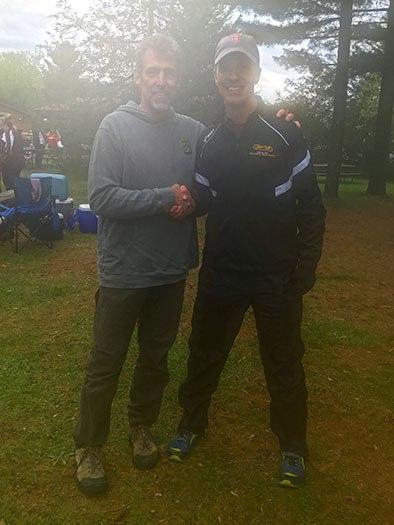
Race Director Jeff Mallach (no thanks to my iPhone lens, which fogged over in the cold)
But as important as redemption was for both of my companions, I can’t help believing that Otter’s triumph carried with it more personal meaning. Otter lost his father just a month before Ice Age, and though I never met David Otto, the legacy of the father shines brightly in the warm, empathetic and incredibly funny man his son has become. I’m guessing the chance to process the emotional whirlwind of the previous month on his own terms, in the welcoming woods of southern Wisconsin, was as powerful and cathartic a motivator as any finisher buckle or quest for redemption could ever be.
The three of us left Wisconsin—state #12 on my 50 states journey—with nothing left to prove. So then what’s next? At 43 states and counting, closing out his own 50 states tour remains Dan’s priority, having put that goal on hiatus to train for Berlin last year and Ice Age so far this year. Otter has yet to settle on his next big challenge, but if I were a betting man I’d lay good money on a 100K, 100-miler or—who knows?—maybe even a multi-stage Desert Challenge in his future.
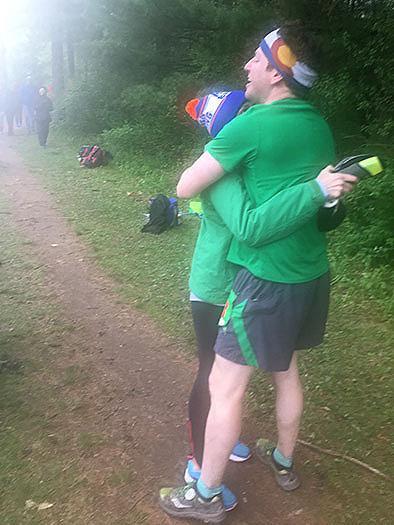
50 miles later, I’m not sure that’s where Lisa’s nose wants to be
Me, I’m still on an Ice Age high as I write this over a week later. That said, I’m already looking toward the next challenge and have two other 50+ milers in mind, including a 56-miler in South Africa that’s calling my name. But not immediately. And next time I’ll be under no delusion, knowing I’ll face considerably more resistance than I did in Kettle Moraine. But for now I need time to process the experience, to let the reality of our group accomplishment sink in and to revel in it. Otherwise what’s the point? If this were a high school yearbook, I might say Ice Age was 2 good 2 be 4 gotten.
Because the truth is, while I love running road races—there’s nothing like the thrill of a World Marathon Major, and both London & Tokyo await—I’m at home out on the trails, where my mind feels uncluttered and my body performs its best. I don’t need screaming spectators or deafening bands to motivate me; on the contrary, the profound quiet of Kettle Moraine State Forest inspired me all day long in a way that few stretches of raucous road outside of Boston ever could. Give me a start & finish line, two excellent running buddies and an all-star crew, and I can run all day.
And now I know that.
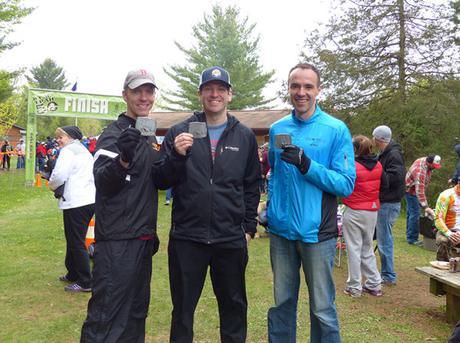
Mission accomplished!
BOTTOM LINE: If you’re a runner looking to make the leap to the 50-mile distance, do yourself a favor and check out the Ice Age Trail 50. It’s the perfect course for 50-mile newbies, a reasonably challenging hybrid of runnable flats and hikable hills. Well-groomed dirt and grass trails make up the bulk of the terrain, which isn’t particularly technical despite numerous rocky ascents & descents (gaiters will help keep those rocks out of your shoes). And speaking of ascents, there are a few relatively steep hills but nothing monstrous, so if you strengthen your core muscles and shore up your power-hiking skills during training, you should be fine.
Kettle Moraine State Forest is a gorgeous venue for the race, particularly in mid-May when spring has sprung and when heat & humidity are less likely to be a factor. If you’re lucky, you may even get the perfectly cool temperatures we got, and two awesome running buddies to join you. I can even recommend the Lake Lawn Resort in nearby Delavan, an easy 25-30 min car ride from the start line, if you’re looking for convenient non-camping accommodations.
The only downside to Ice Age is the two-way traffic on the out-and-backs, though this only became a problem with a handful of runners who—for whatever reason—came barreling down the center of the trail refusing to yield the right-of-way. This could have resulted in some nasty collisions had the rest of us not been hypervigilant and quick to step aside. As with any event, though, it’s tough to police assholery.
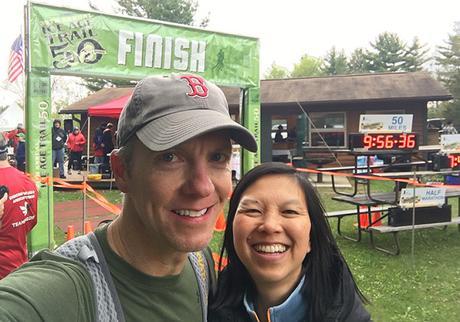
Me, the finish and the reason I reached the finish
PRODUCTION: Race-day production was top-notch. Despite being one of the largest 50-milers in the country, Ice Age reminded me why I miss low-key trail races. The course was clearly marked with yellow (50M) and/or orange (50K) flags at every turn, aid stations were well-stocked and well-spaced (the longest interval between stations was 5.1 miles, and that was at mile 9), and without exception the volunteers were nothing short of brilliant. After all, these folks were selflessly sacrificing an entire day of their lives so the rest of us could work through personal issues run an absurdly long way. I introduced myself to Race Director Jeff Mallach after the race, and he seemed genuinely surprised and appreciative that we’d made the trip from California just to run his race.
The only potential issue—and one I never encountered personally—was a shortage of medical personnel & supplies on the course, e.g. when Steve drove the fellow who’d sustained a bloody gash beside his eye back to the start/finish area for medical attention.
SWAG: How to argue with my first-ever ultra buckle? The Ice Age buckle with its woolly mammoth logo is one good-looking piece of hardware. Credit to RD Jeff Mallach for not subscribing to the “Bigger is better” mentality—as with other things, garishly large medals smack of a race trying to make up for something. And though the long-sleeve tech tee may be a bit bright, its lime green color will go a long way toward making me visible to oncoming traffic on my training runs.
Read Dan’s excellent Ice Age recap HERE.
For a different perspective, which will make you want to either sign up for this race immediately or flee in the other direction, check out Jeff Lung’s recap of the 2012 Ice Age Trail 50 HERE.
Read Otter’s recap of the 2013 North Country Run, his first 50-miler, HERE.
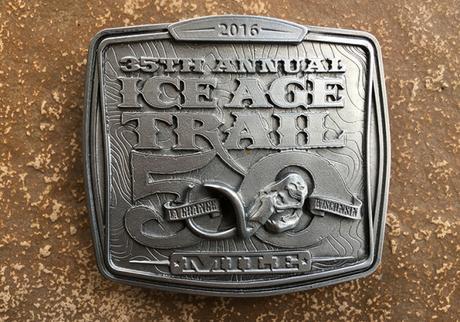
FINAL STATS:
May 14, 2016 (start time 6:04am)
50 miles in Kettle Moraine State Forest, Whitewater, WI (state 12 of 50)
Finish time & pace: 9:54:30 (first time running the Ice Age Trail 50), 11:54/mile
Finish place: 95 overall, 15/40 in M 45-49 age group
Number of finishers: 297 (208 men, 89 women)
Race weather: cold & cloudy at the start (temp 39°F) and finish
Elevation change (Garmin Connect): 2,472 ft ascent, 2,510 ft descent through 41 miles
Elevation change (Strava, based on Otter’s Suunto data): 6,762 ft through 50 miles
~6,000 calories burned, ~2,000 calories replaced
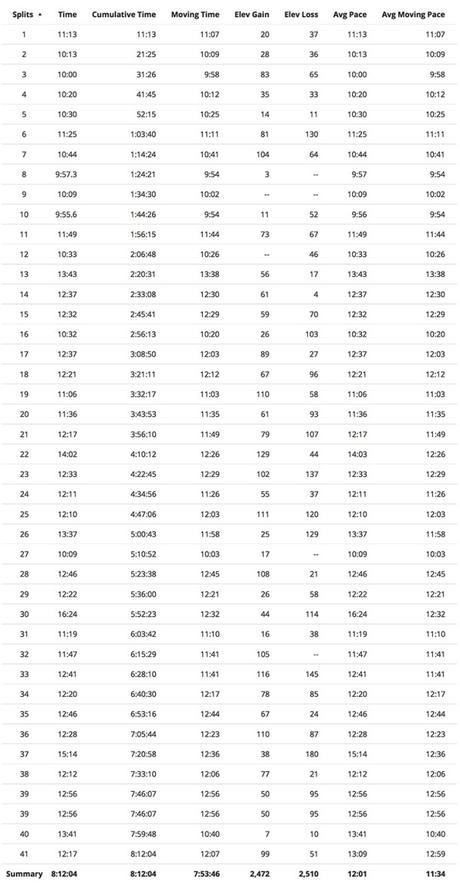
It’s all fun & games until the Garmin dies at mile 40.93 (actually, it was all fun & games after that, too)
